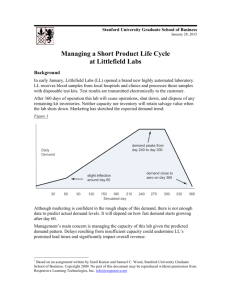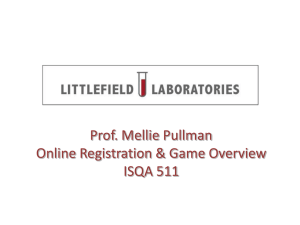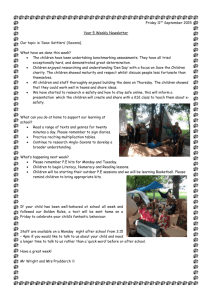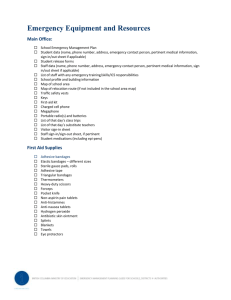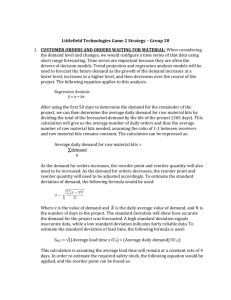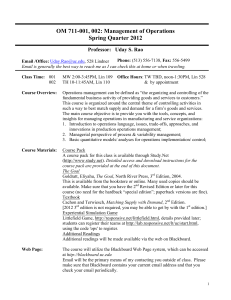Managing a Short Product Life Cycle at Littlefield Labs
advertisement
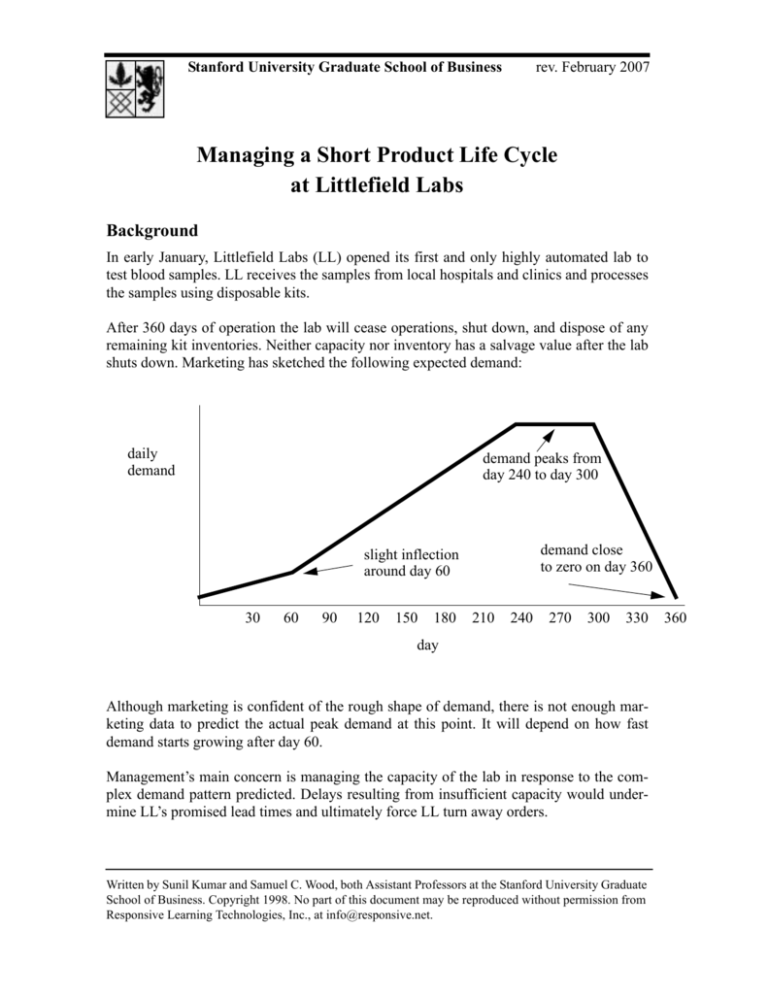
Stanford University Graduate School of Business rev. February 2007 Managing a Short Product Life Cycle at Littlefield Labs Background In early January, Littlefield Labs (LL) opened its first and only highly automated lab to test blood samples. LL receives the samples from local hospitals and clinics and processes the samples using disposable kits. After 360 days of operation the lab will cease operations, shut down, and dispose of any remaining kit inventories. Neither capacity nor inventory has a salvage value after the lab shuts down. Marketing has sketched the following expected demand: daily demand demand peaks from day 240 to day 300 demand close to zero on day 360 slight inflection around day 60 30 60 90 120 150 180 210 240 270 300 330 day Although marketing is confident of the rough shape of demand, there is not enough marketing data to predict the actual peak demand at this point. It will depend on how fast demand starts growing after day 60. Management’s main concern is managing the capacity of the lab in response to the complex demand pattern predicted. Delays resulting from insufficient capacity would undermine LL’s promised lead times and ultimately force LL turn away orders. Written by Sunil Kumar and Samuel C. Wood, both Assistant Professors at the Stanford University Graduate School of Business. Copyright 1998. No part of this document may be reproduced without permission from Responsive Learning Technologies, Inc., at info@responsive.net. 360 Operations at Littlefield Labs Littlefield Labs uses one kit per blood sample and disposes of the kit after the processing of the sample is completed After matching the sample to a kit, LL then processes the sample on a four step process on three machines as shown below: Step 1 Sample Preparing $25,000 per tool Steps 2 and 4 Tester $75,000 per tool Step 3 Centrifuging $75,000 per tool The purchase price of each machine is shown above as well. The retirement price of each machine is $10,000 if the machine is retired before day 360. Although management has not performed any stopwatch studies of the four different process steps, it knows there is virtually no variability in a given step’s process time from job to job. Earlier steps are longer than later steps, so Step 1 is longer than Step 2, which is longer than Step 3. Step 4 is the shortest step. One raw kit costs $100. A reliable supplier delivers exactly the order quantity of batches, two weeks after the order is placed and paid for. Placing an order costs $1000 plus the cost of the kits. Management considers physical cost of holding inventory negligible compared to the opportunity cost of lost interest on money sunk in inventory. The interest is 10% per year, compounded daily. LL uses a Reorder Point / Order Quantity raw material purchase policy. That is, raw kits are purchased as soon as the following three criteria are all met: (1) the inventory of raw kits is less than the reorder point, (2) there are no orders for raw kits currently outstanding, and (3) the lab has sufficient cash to purchase the reorder quantity. No order is placed if any of these three criteria are not met. So, for example, a team could prevent orders from being placed at all by setting the order quantity so high that there is insufficient cash to place an order. Customers are willing to pay a premium for fast lead times, and you now have three pricing contracts to choose from. The price is per sample. • price = $200; quoted lead time = 7 days; maximum lead time = 14 days. (This is the contract that the lab starts with.) • price = $225; quoted lead time = 1 day; maximum lead time = 7 days. • price = $250; quoted lead time = 0.25 days; maximum lead time = 1 day. If an order’s lead time exceeds the quoted lead time, then the revenue for that order decreases linearly from the prices above for the quoted lead time to $0 at the maximum lead time. A contract is assigned to an order as soon as it arrives at the lab, and that order’s contract cannot be changed subsequently. Assignment It is now early February and LT has installed a high-powered health operations management team (you) to manage the lab’s capacity. For the next 330 simulated days you must buy or sell machines, set inventory policies, and quote lead times to maximize the lab’s overall cash position. Currently there is one stuffer, one tester, and one tuner. You may also change the way testing is scheduled. Currently jobs at the tester are scheduled FirstIn-First-Out (FIFO), but you can give priority status either to the long initial test or the short final test. There are 30 days of history available for your review, representing the period from early January to late February. Once the assignment begins, the simulator will run at a rate of 3 simulated days per 1 real minute for the next 110 minutes. Thus, there will be a total of 360 days of simulation corresponding to a lab life time of a year. The winning team is the one with the most cash at the end of the game. Icons on the Littlefield Labs web page: ICON Order Queue: INFORMATION AVAILABLE • Number of new customer orders by day • Average number of orders waiting for kits by day • Current pricing contract for arriving orders • Lot size Materials Buffer: • Number of kits (raw materials) in the buffer at the beginning of each day, whenever inventory hits zero, and whenever new shipments arrive Station Queues: • Average number of samples waiting while all the machines in the station are busy, by day Stations: • Number of machines in each station • Scheduling Policy used (for tester only) • Historical utilization of the station by day (i.e., the average fraction of time a machine was busy at that station during that day) Completed Jobs: • Numbers of orders completed by day (by pricing contract) • Average order lead time by day (by pricing contract) • Average revenue per order by day (by pricing contract) Clicking on the above icons will also enable you to change certain features of the lab such as the number of machines in a station. Sources and uses of cash can be obtained by clicking on the cash button on the web page. Sources of cash are revenue, money raised from the sale of machines, and interest. Uses of cash are raw material (kit) purchases and the purchase of additional machines. Finally, you can check the overall standing of your team using the overall standing button.
